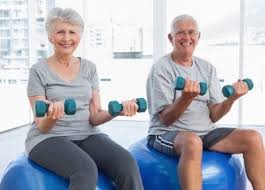-
Your shopping cart is empty!

There are four ways for elderly patients to improve physical fitness: aerobics, resistance training, flexibility training, and lifestyle modification. Exercise prescriptions will vary depending on the desired outcomes however, they should include a combination of activities to optimise health outcomes and encourage patients to stay with the program. The activities and intensity levels should depend on the patient's daily health and energy needs, and the training routine should vary to maintain interest and promote optimal gains. For frail patients, chair-based exercises can be used as a starting point.
Types of exercises
Aerobic Exercises
Exercise that involves repetitive motions, uses large muscle groups, increases heart rate for an extended period, and raises core body temperature (e.g., walking, dancing, swimming).
Balance Training
Exercise that helps maintain stability during daily activities and other exercises, preventing falls. It can be static (for example, standing on one leg) or dynamic (such as walking a tightrope), with hand support as needed.
Flexibility or stretching exercises
Exercise that lengthens muscles to increase a joint's capacity to move. Stretches can be static (assume position, hold stretch, then relax); dynamic (fluid motions like Tai Chi ); active (balance while holding stretch, then moving, as with yoga); or a combination (proprioceptive neuromuscular facilitation).
Power exercises
Exercise that improves the muscle strength, for example performing tasks like carrying grocery bags with ease.
Progressive resistance trainings
Exercise that requires muscles to generate force to move or resist weight, with the intensity increasing as physical capacity improves (e.g., strength training)
Implementing a training program
Lifestyle modification
Simple lifestyle changes can greatly impact fitness. For example, walking a dog, taking the stairs as much as possible, parking far away from venues and then walking, and doing simple yard work are all ways in which a patient can improve their overall health.
Aerobic exercise
Simple aerobic exercise can have great cardiovascular benefits, whether it be walking, swimming, or even dancing.
Flexibility training
Flexibility is an important part of a senior's health. Gentle exercises like yoga can really help the patient to maintain their flexibility as they grow older.
Progressive resistance training
Resistance training is a great way to build and maintain muscle mass. For seniors, group circuit training can be a great addition to their fitness routine.
Safety first
As any new exercise program can have serious risks, particularly in those who are frail, check with your doctor if you’re over 50 and aren’t used to exercising before starting an exercise routine, particularly if you've recently had surgery or any serious health problems. Wear loose, comfortable clothing and well-fitting, sturdy shoes.
References